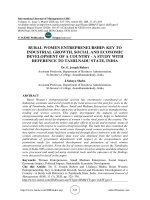Economic growth and economic development 69
Bạn đang xem bản rút gọn của tài liệu. Xem và tải ngay bản đầy đủ của tài liệu tại đây (132.87 KB, 1 trang )
Introduction to Modern Economic Growth
k(t+1)
45°
sf(k(t))+(1−δ)k(t)
k*
ε
0
k*
k(t)
Figure 2.3. Unique steady state in the basic Solow model when
f (0) = ε > 0.
two other purposes. First, it depicts the levels of consumption and investment in
a single figure. The vertical distance between the horizontal axis and the δk line
at the steady-state equilibrium gives the amount of investment per capita (equal to
δk∗ ), while the vertical distance between the function f (k) and the δk line at k∗
gives the level of consumption per capita. Clearly, the sum of these two terms make
up f (k∗ ). Second, Figure 2.4 also emphasizes that the steady-state equilibrium in
the Solow model essentially sets investment, sf (k), equal to the amount of capital
that needs to be “replenished”, δk. This interpretation will be particularly useful
when we incorporate population growth and technological change below.
This analysis therefore leads to the following proposition (with the convention
that the intersection at k = 0 is being ignored even when f (0) = 0):
Proposition 2.2. Consider the basic Solow growth model and suppose that Assumptions 1 and 2 hold. Then there exists a unique steady state equilibrium where
55









